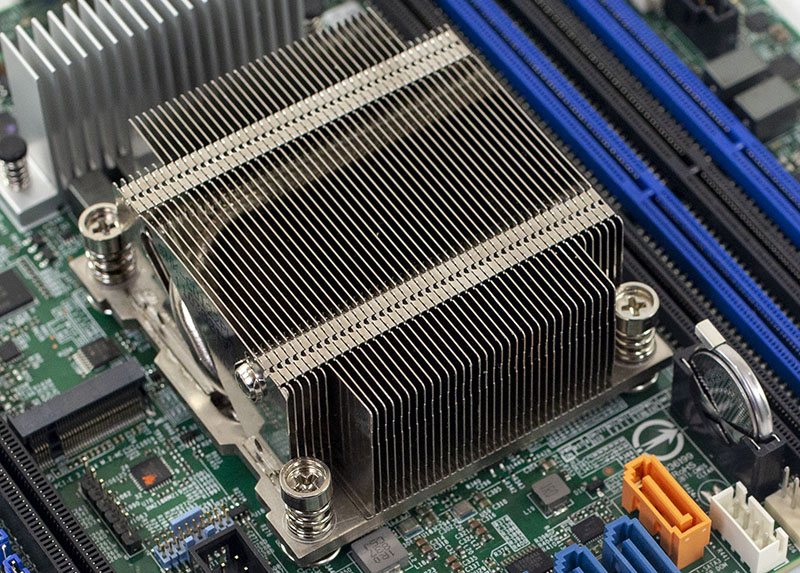Supermicro M11SDV-8CT-LN4F Power Consumption
We used our pair of Extech TrueRMS Power Analyzer 380803 units to take measurements at different points of the Supermicro M11SDV-8CT-LN4F use on 120V power in the embedded lab. Embedded platforms tend to spend more time at the edge in offices rather than in higher power data centers, hence why we do our testing at a lower voltage. Here are the figures:
- Power off BMC only: 4.5W
- OS Idle: 24.3W
- 100% Load: 48.6W
- Maximum Observed: 50.4W
These are solid results. The Supermicro M11SDV-8CT-LN4F performs well and at a lower power level than many of the Intel Xeon D-2100 performance competitive solutions. In the embedded market, low power is key.
Final Words
The AMD EPYC 3201 on the Supermicro M11SDV-8CT-LN4F is surprisingly fast. It is also refreshing. AMD did not just differentiate its line by small MHZ increments. Instead, there are real differences between the SKUs. Supermicro has done a great job of keeping pricing close for options that our readers may try to decide between. That is especially welcome on a first-generation platform.
There is a segment of the market that wants to diversify from Intel for at least a portion of their portfolio. In the past, that meant going to an Arm server involving porting code. The Supermicro M11SDV-8CT-LN4F changes this paradigm. Most code can be run out-of-the-box on its AMD EPYC 3201 processor. When new security vulnerabilities like Foreshadow/ L1TF are found in an architecture well into its lifecycle, having another vendor that is or may not be vulnerable is important.

We still wish that Supermicro had found a way to add the AMD EPYC 3000 series quad 10GbE networking onboard. One could argue that there is little to no extra room on the motherboard to put 10GbE cages and that a 10Gbase-T PHY would use too much power and space as well. We understand the design direction, even if we still wish there was a possibility.
Sharing many of the same I/O placements as Supermicro’s other embedded offerings making integration as alternatives to the company’s other Intel offerings as easy as changing the motherboard part. The platform has worked well for us during testing out-of-the-box. For our readers looking to an alternative to Intel platforms that is low power yet highly performant, the Supermicro M11SDV-8CT-LN4F should be high on the list of options.




Hi Patrick, LOVE these reviews and glad to see a website focused to the whitebox datacenter/homelab folks.
I always wondered why you don’t run PassMark benchmarks? I know they aren’t the most representative of real-world perf, but the Single Thread Rating is, in my opinion the best way to compare IPC.
Sadly no 10GbE, seems a bit of a waste – non of the embedded EPYC solutions by Supermicro support this.
There is no excuse for not offering the 10G option, it’s mandatory for a server board these days. And for embedded use, it’s simply overkill in most cases. They completely missed the correct positioning, as usual. Nothing new, they completely killed Denverton by giving up the flexible IO and offering unreasonable options. It seems they cannot even design a compact chassis: what the hell is this CSE-E301 pie? What about designing a decent compact 1.5U or a 2U with 60mm/80mm fans and a PCI card slot at the top like on any server on earth? And maybe add an AC/DC board on the side? I’m not asking for something as fancy as a Mac Mini, but I mean… is it too difficult for you guys? What’s wrong with you? What’s wrong? I wish the were alternative brands.
Any opinions on getting this board vs waiting for Supermicro Xeon D-1600 options? Is the D-1612 likely to be performance competitive with this board, but with 10GbE?
I’m wondering as well. Also, when can we expect Intel Denverton successors? I’m in the market for a new home server / NAS but I’d like to buy future proofed HW.
Can anyone tell me if this board / cpu combo has h265 hardware acceleration?
It does not. There is no integrated GPU onboard.
What for RAID Controllers are Working ?
I am try to use 3Ware (LSI) 9690SA Series also 9590SE Series but no chance
Is the LSI SAS9207-8i working stable or any others ?